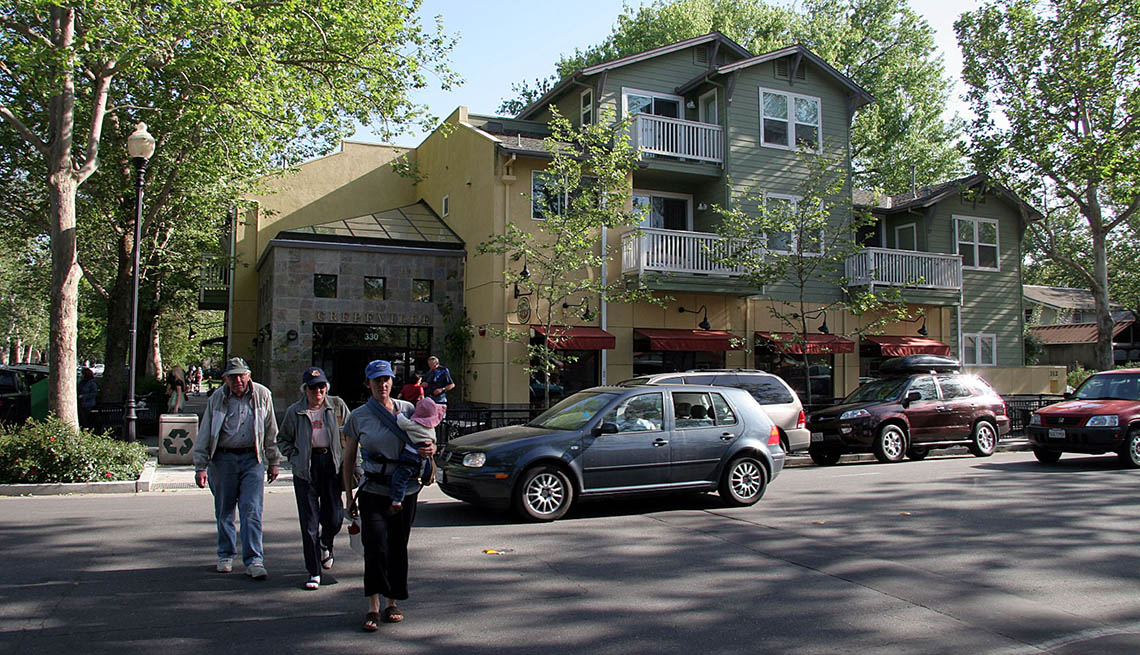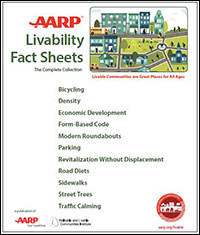The Tools: Long-Range Projects
These placemaking solutions can take many years to put in place
Editor's Note: The Walkable and Livable Communities Institute, AARP Livable Communities' partner in creating The Imagining Livability Design Collection, has closed shop. However, the 40-page publication the nonprofit helped develop in 2015 remains a valuable resource for communities and local leaders.
The transformations presented here show real locations as they appeared during visits by AARP and WALC between 2010 and 2015. WALC helped each community develop a vision for the future, and it created photovisions to reflect those changes and how each place could be made better.
With short-term and mid-range treatments in place, the area becomes safer and more attractive to residents and others, including developers. When that happens, new policies and mixed-use development can help transform a street or entire neighborhood into a more livable and prosperous place. Long-range initiatives can be relatively low-cost, especially if they're focused on policy change, but the efforts generally take several years to fully implement.
Sprawling development and "strip malls" commonly feature buildings that are set back from the street with large surface parking lots in front. Liner buildings help convert this type of development into a pedestrian-scaled area by replacing a part of the surface parking with buildings that "line" the edge of the former parking lot and are close to the street and adjacent to sidewalks. Transparency (i.e. the amount of window space) is an important feature and benefit of liner buildings, which, when located in retail areas, should be at least 70 percent "transparent" on the street-facing side. Liner buildings create a sense of place, enhance the liveliness of a community and, as "eyes on the street," its safety. Over time, the old strip mall-style buildings can be redeveloped so the entire area becomes more of an urban village.
Buildings that are designed for mixed uses are more efficient than single-use and single-floor buildings, and they contribute to a more prosperous, people-friendly environment. A building of two to eight stories, with retail on the bottom floor facing the street and office or residential uses on the upper floors, creates a much higher return on investment, with greater long-term tax revenue and a more walkable and healthy community.
This article, "The Tools: Long-Range Projects," was adapted from The Imagining Livability Design Collection, which was published in Spring 2015 by AARP Livable Communities and the Walkable and Livable Communities Instiitute (WALC), written by Kelly Morphy and Robert Ping (WALC) and project managed and edited by Jeanne Anthony and Melissa Stanton (AARP)
Read another excerpt from the collection. »
Our Other "Don't Miss" Resources Include
- AARP Livability Fact Sheet Series (pictured)
- AARP Livable Communities Slideshows
- AARP Livable Communities Interviews
- AARP Livable Communities How To's
- AARP HomeFit Guide
- AARP Network of Age-Friendly Communities
- AARP Livable Communities A-Z Archives
Stay Informed: Subscribe to the free, AARP Livable Communities Monthly e-Newsletter!
Featured Video
Learn how to check the "livability score" of any address in the U.S.
Stay Informed — For Free!
AARP.org/Livable
Enter a topic, name, place, etc.






